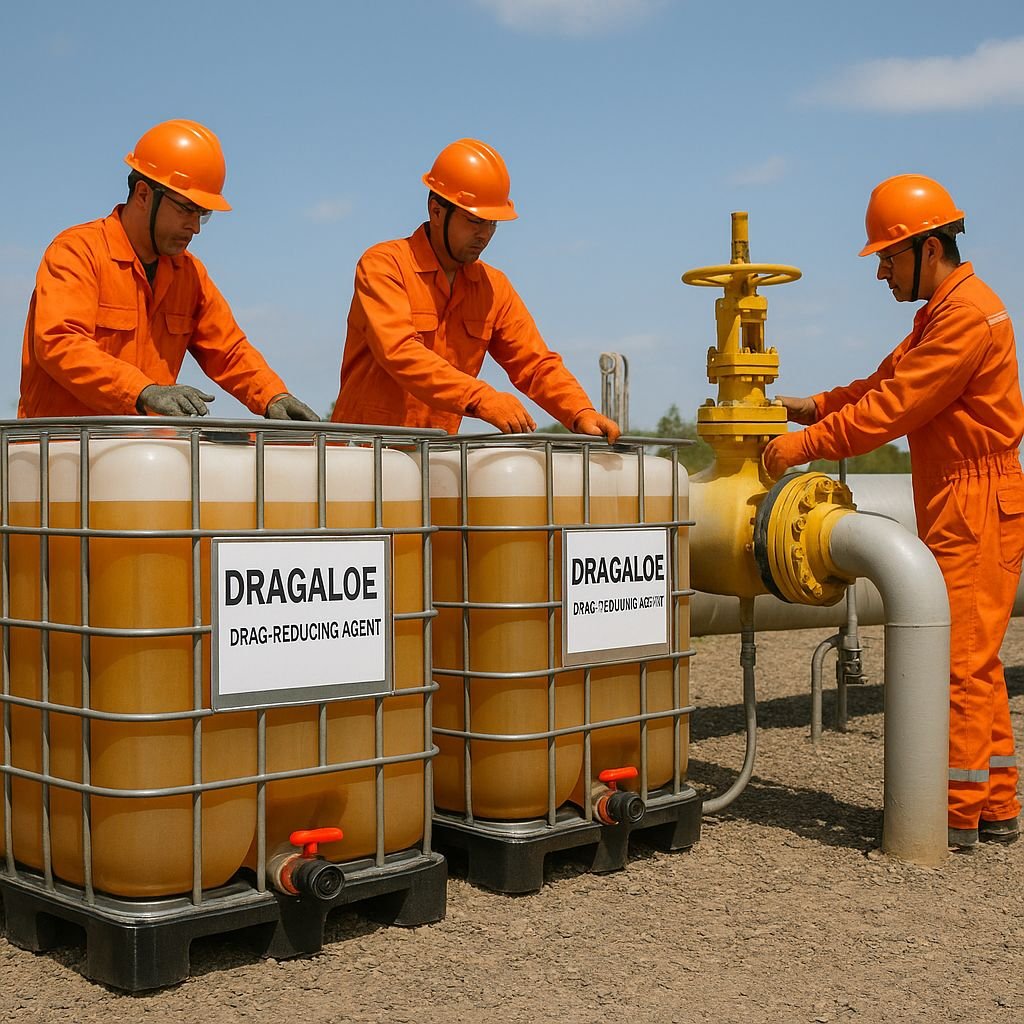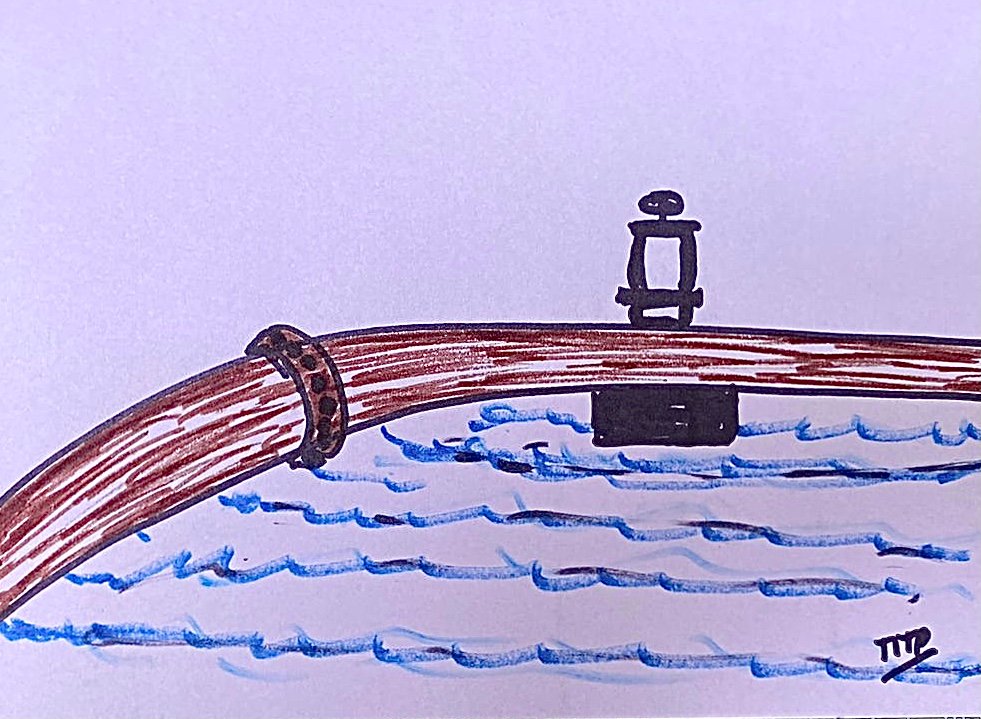How long a Drag reducing agent is used to clean a pipe?
DRA in Pipe Maintenance
The duration for which a drag-reducing agent (DRA) is used in pipe cleaning depends on several factors, including the type of pipeline, the nature of the fluid being transported, the degree of fouling or buildup, the specific DRA used, and the operational conditions of the pipeline (e.g., flow rate, pressure, temperature, and pipe diameter), among other minor factors.
DRAs are typically not used as standalone cleaning agents but rather as additives to enhance flow efficiency by reducing turbulence and frictional pressure loss in pipelines, which can indirectly aid in maintaining cleaner pipes.
Role of Drag-Reducing Agents in Pipe Cleaning
DRAs, often high-molecular-weight polymers or surfactants, are primarily used to reduce turbulence in pipelines, particularly in petroleum or natural gas pipelines, to increase flow capacity or reduce energy costs. While they are not traditional cleaning agents like chemical drain cleaners, DRAs can contribute to pipe maintenance by:
- Reducing frictional pressure loss: By promoting laminar flow, DRAs minimize turbulence-induced drag, which can help prevent the buildup of deposits like wax, paraffin, or scale by keeping the fluid moving more smoothly.
- Facilitating cleaning processes: In some cases, DRAs are used alongside cleaning operations (e.g., pigging or chemical cleaning) to enhance fluid flow, allowing cleaning agents or tools to move more efficiently through the pipeline.
- Preventing clogging: By reducing turbulence, DRAs can help prevent the settling of solids or heavy hydrocarbons that might otherwise contribute to blockages.
However, DRAs are not typically used to directly dissolve or remove clogs like chemical drain cleaners (e.g., those containing sodium hydroxide or bleach, as described in and). Their role in cleaning is more about maintaining flow efficiency and preventing buildup rather than actively removing existing deposits.

Duration of DRA Use in Pipe Cleaning
The duration of DRA application in a pipeline, whether for maintenance or as part of a cleaning process, varies based on the following considerations:
- Continuous vs. Intermittent Use:
- Continuous Injection: In many oil and gas pipelines, DRAs are injected continuously at low concentrations (e.g., 2–100 ppm) to maintain flow efficiency over long periods. For example, in the Trans-Alaska Pipeline, DRAs have been used since 1979 to reduce drag by up to 50%, allowing continuous operation without frequent cleaning interruptions. This continuous use can last for months or years, with periodic re-injection to counter degradation (see below).
- Intermittent Use for Cleaning: If DRAs are used as part of a specific cleaning operation (e.g., to enhance flow during pigging or chemical flushing), the duration is typically shorter, ranging from hours to days, depending on the pipeline length and cleaning requirements. For instance, a cleaning operation for a 150 km pipeline (as mentioned in) might involve DRA injection for a few hours to a day to optimize flow during the process.
- Degradation of DRAs:
- DRAs, particularly polymer-based ones, are susceptible to shear degradation due to high shear forces from pumps, valves, or bends in the pipeline. This degradation reduces their effectiveness over time, necessitating re-injection. For example:
- In high-shear environments, polymer DRAs may degrade within hours, requiring re-injection downstream of pumps or high-shear equipment.
- Surfactant-based DRAs or newer formulations like partially dissolved poly(ethylene oxide) slurries (as in) may have longer effective lifetimes, potentially lasting days before needing replenishment.
- The frequency of re-injection depends on the pipeline’s operating conditions. For instance, in a crude oil pipeline, DRAs might be re-injected every few kilometers or after high-shear points like pumps.
- DRAs, particularly polymer-based ones, are susceptible to shear degradation due to high shear forces from pumps, valves, or bends in the pipeline. This degradation reduces their effectiveness over time, necessitating re-injection. For example:
- Pipeline-Specific Factors:
- Pipeline Length and Diameter: Longer pipelines (e.g., 800 miles in the Trans-Alaska Pipeline) or smaller-diameter pipes (which have higher drag) may require more frequent or prolonged DRA use to maintain flow efficiency during cleaning or operation.
- Type of Fluid: Crude oil, refined products, or multiphase flows (e.g., oil-water mixtures) affect DRA performance. For example, DRAs are effective in turbulent flow regimes common in petroleum pipelines but not in laminar flow,. Cleaning operations for heavy crude might require higher DRA concentrations or longer application times due to higher viscosity.
- Operating Conditions: Higher temperatures or pressures can accelerate DRA degradation, reducing their effective duration. For instance, at higher temperatures, polymer DRAs are more prone to breaking down, requiring more frequent re-injection. Laboratory tests (e.g.,) show that drag reduction stabilizes quickly (within minutes) at high rotational speeds but may degrade faster under high Reynolds numbers.
- Cleaning Operation Type:
- Pigging with DRAs: When DRAs are used to enhance flow during pipeline pigging (a common cleaning method), the duration of DRA injection typically aligns with the pigging operation, which can take hours to days depending on pipeline length. For example, a 150 km pipeline might require 6–24 hours of pigging, with DRA injected intermittently to maintain flow efficiency.
- Chemical Cleaning: If DRAs are used alongside chemical cleaners (e.g., to flush out wax or scale), the duration depends on the cleaning agent’s contact time, which is typically 10 minutes to several hours for drain cleaners (as in,). However, DRAs would be injected throughout the process to maintain flow, potentially extending to a few hours or a day.
- Preventive Maintenance: For ongoing maintenance to prevent buildup, DRAs might be injected continuously or periodically (e.g., daily or weekly) at low concentrations to keep the pipeline clean.
- Experimental and Field Data:
- Laboratory studies (e.g.,,) indicate that DRA performance has an initial rapid growth stage (within seconds to minutes) followed by a stabilization stage where drag reduction remains effective for a period. The stabilization time is shorter at higher DRA concentrations (e.g., 100 ppm) and higher flow rates, but shear degradation can limit effectiveness to hours or less in high-shear conditions.
- Field tests, such as those in the Trans-Alaska Pipeline, show that DRAs can maintain effectiveness over long distances (e.g., 1300 km) with periodic re-injection, suggesting that continuous use can extend for months with proper management.
- In a specific field test cited in, modified DRAs at low concentrations (2 ppm) achieved performance equivalent to 20 ppm of standard DRAs in an 8-inch pipeline, indicating that advanced formulations may extend the effective duration before re-injection is needed.
Typical Duration Estimates
Based on the above factors, here are approximate durations for DRA use in pipe cleaning or maintenance:
- Short-Term Cleaning Operations: For specific cleaning tasks (e.g., pigging or chemical flushing), DRAs may be injected for hours to a day, depending on the pipeline length and cleaning method. For example, a 300 mm diameter, 150 km pipeline might require DRA injection for 6–24 hours during a pigging operation.
- Continuous Maintenance: In operational pipelines, DRAs are often used continuously at low concentrations (e.g., 2–20 ppm) to prevent buildup, with re-injection every few hours to days to counter degradation, especially in high-shear environments.
- Stabilization Period: Laboratory tests show that DRAs reach a stable drag reduction effect within seconds to minutes after injection, but this effect may last only hours in high-shear or high-temperature conditions before degradation requires re-injection.
Comparison to Drain Cleaners
It’s worth noting that DRAs differ significantly from chemical drain cleaners used in household or industrial plumbing.
Drain cleaners, such as those containing sodium hydroxide or bleach, are designed to dissolve organic matter or grease and typically act within 10 minutes to 1 hour (or overnight for tough clogs).
DRAs, however, are not reactive in this way and are used to enhance flow rather than directly clean, so their “duration” is tied to flow maintenance rather than a chemical reaction time.
Factors Affecting Duration
- Concentration: Higher DRA concentrations (e.g., 100 ppm) lead to faster stabilization but may degrade quicker under shear.
- Shear Forces: Pumps, valves, and bends cause shear degradation, reducing DRA effectiveness and requiring more frequent re-injection.
- Temperature: Higher temperatures accelerate DRA degradation, shortening the effective duration.
- Pipeline Conditions: Rougher pipe surfaces or smaller diameters increase drag, potentially requiring longer or more frequent DRA use.
- DRA Type: Surfactants or modified polymers (e.g., poly(ethylene oxide) slurries) may last longer than traditional polymers due to better shear resistance.
Practical Considerations
- Injection Strategy: DRAs are typically injected downstream of high-shear equipment (e.g., pumps, valves) to minimize degradation. For cleaning, operators may use automated injection systems to maintain consistent DRA levels over the cleaning period.
- Optimization: Tools like Seeq’s advanced analytics or Simcenter Flomaster can help determine optimal DRA injection rates and durations to balance cost and effectiveness, especially for long-term maintenance.
- Environmental and Cost Factors: DRAs are expensive, and over-injection can increase costs without proportional benefits. Optimizing injection frequency and concentration is critical, as noted in and.

Final Comments
Drag-reducing agents are not primarily used for pipe cleaning but rather to enhance flow efficiency, which can indirectly aid in maintaining cleaner pipelines by reducing turbulence and preventing deposit buildup.
The duration of DRA use depends on the application:
- For specific cleaning operations (e.g., pigging or chemical flushing), DRAs may be injected for hours to a day.
- For ongoing pipeline maintenance, DRAs are used continuously or intermittently over weeks to months, with re-injection every few hours to days to counter degradation.
- Laboratory studies suggest stabilization within seconds to minutes, but effectiveness may last only hours in high-shear or high-temperature conditions.
For precise durations, operators must consider pipeline-specific factors (length, diameter, fluid type, shear forces) and use monitoring tools to optimize DRA application.
For more information about our Drag Reducing Agent DRAGALOE™, please visit the product page.